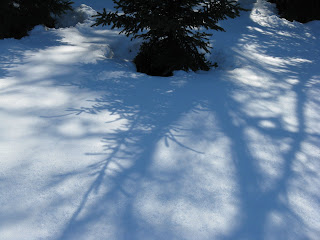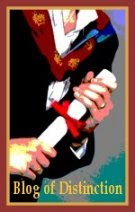
High: 48° F
Low: 26° F
Conditions: Winter weather advisory. Sleet and freezing rain changing to all rain by afternoon.
Today is the last day of Audubon’s Backyard Bird Count, and we’ve slipped into a structured rhythm here at the house. Each morning, Ari takes her place at the north-facing dining room window, where she surveys the bird feeders.

The sister cats settle for the east-facing windows above the bookcase, where there is better seating but no feeders and, thus, considerably inferior viewing.

The humans mostly mill about, sipping hot tea and listening to “Morning Edition” on NPR (who said one must suffer for science?).
This routine all seems very tidy and casual, until someone tries to improvise. Ari will not tolerate anyone sharing her window. When Mouse tries, she is punished by having her entire head engulfed in Ari’s mouth. When Leila Tov signals with her tail that she has seen something interesting, Ari tries to evict her from her stoop to take over. This prompts the humans to scold the dog, which makes Mouse meow in gleeful retribution. The ruckus sends the timid Leila Tov scurrying, taking the candles with her and invariably scaring all of the birds in the vicinity.
So it’s not a perfect system. But it has still allowed continued avian viewing. And we’re beginning to realize that a very similar social pecking order is taking place just outside these very busy windows. There, the hairy woodpecker is always the first to alight. He’s also the first to be spooked and leave. Soon after, he is followed by the only slightly more intrepid nuthatches (both red- and white- breasted), who are then shooed away by the brassy redpolls. These birds are ruthlessly pack-oriented, and think nothing of pushing one another off the feeder.
Their aggression makes for messy eating, which in turn delights the red squirrel, who lurks in the crab apple tree, just waiting for an excuse to stuff his cheeks with dropped seed.

If there is one thing everyone in our house can agree upon, it’s that the red squirrel has no place at our feeders. In an instant, the cats convert into military special operatives: every pore seems to shout
killing machine as they try to figure out how to unlock the window and eat the squirrel. Ari, not nearly so focused in her animosity, simply barks her objections (or maybe her glee?).
.
The only creature not disturbed by this interspecies racket is the black-capped chickadee (
Parus atrica). The chickadee is as common a bird as you’ll see in Maine, which may be one reason why it’s also our official state bird. This prevelence used to disqualify the bird from our list of interesting species, but lately we’ve had to reconsider. The chickadee is the only bird brazen enough to stand up to the redpolls, the squirrel, and the racket inside our house. Each day, we’ve counted them by the dozens. And in truth, they’re hard to miss with all of their lively chatter.

Their presence delights Ari, who likes nothing more than to be engaged by little creatures in trees. Sometimes, we think this is craziness on her part. But when it comes to the state bird, who greets us in any weather and under any circumstance, we can't help agree.
A special thanks to all of our blog friends who have sent in their sightings! Khyra reported a Khoopers Hawk in Pennsylvania, and Tubey eyed an eastern bluebird down in Missouri. Zim gazed at geese in Kansas; the D'Azul Siberians even counted chickens! But the winner of our bird count challenge is. . . .
Marigold, the Goat Philosopher! Check out the email we received from her:
Hi! Here is a count from 'Marigold' on the Olympic Peninsula in
Washington!
A male and female Mallard (they had 9 ducklings in our pond last year and they just reappeared, so spring must have sprung! :))
~ 30 dark-eyed
Juncos (regular winter residents at the feeder)
3 Red-Breasted Nuthatch
A large flock of ~50 Pine Siskins (they have good years and bad years, so this must've been a good year :))
4 Spotted Towhees6 Stellar Jays
2 Douglas squirrel (okay, not a bird but at the feeder :))
~8 Purple Finch
2 Varied Thrush
2 Northern Flickers (red shafted)
1 Mourning Dove
3 Red-Winged Blackbirds
3 Starlings
~30 - 40 Robins (at one time, no kidding)
2 Chestnut-backed Chickadees
1 Red Breasted Sapsucker
1 Cooper's Hawk (attempting to 'raid' the bird feeder)
1 Great Blue Heron (looking to land in our pond, but either saw the pair of ducks or me feeding the goats and decided to go work on the neighbor's goldfish :))
2 Canadian Geese (that flew over just after the Heron)
and last and most incredibly 3 Trumpeter swans!
(Overwinter here and live in the pond across the highway from us).
Wow. Now THAT’s caninaturalism (and from a ruminant, nonetheless)! We have a special thank-you surprise for Marigold and her human friend, Maryann. And you dog fans out there will want to be sure to check out their
blog soon. Rumor has it Marigold has a new puppy. Thanks to everyone who participated in the count: we had great fun, and hope you did too!






 .
. .
.



 The sister cats settle for the east-facing windows above the bookcase, where there is better seating but no feeders and, thus, considerably inferior viewing.
The sister cats settle for the east-facing windows above the bookcase, where there is better seating but no feeders and, thus, considerably inferior viewing. The humans mostly mill about, sipping hot tea and listening to “Morning Edition” on NPR (who said one must suffer for science?).
The humans mostly mill about, sipping hot tea and listening to “Morning Edition” on NPR (who said one must suffer for science?).






 Lovely! Now all we need is a partridge (
Lovely! Now all we need is a partridge (



 Her more reserved sister, Leila Tov, has smartly decided to pace herself for the long weekend, and is currently catching up on sleep near the fireplace.
Her more reserved sister, Leila Tov, has smartly decided to pace herself for the long weekend, and is currently catching up on sleep near the fireplace. Hopefully, that will mean she has more energy for blogging. We might need it: each day, we’ll be compiling reports from around the area and from the blogosphere. Regardless of where you live or whether you’ll be participating in the actual count, we’d love to hear from you! Send any observations or sightings to us by email (
Hopefully, that will mean she has more energy for blogging. We might need it: each day, we’ll be compiling reports from around the area and from the blogosphere. Regardless of where you live or whether you’ll be participating in the actual count, we’d love to hear from you! Send any observations or sightings to us by email ( John James Audubon (1785-1851) loved dogs. Although the above sketch show him with a setter, that was not his preferred breed of choice. Like many naturalists of his era—including explorer Meriweather Lewis and park planner Frederick Law Omstead—Audubon shared his fieldwork with an affable Newfoundland. Audubon’s was named Plato, and the naturalist wrote regularly of the Newfie’s intelligence and wise demeanor. Local legend suggests that the two of them actually wandered not far from our house, looking for boreal forest birds. That appeals to us.
John James Audubon (1785-1851) loved dogs. Although the above sketch show him with a setter, that was not his preferred breed of choice. Like many naturalists of his era—including explorer Meriweather Lewis and park planner Frederick Law Omstead—Audubon shared his fieldwork with an affable Newfoundland. Audubon’s was named Plato, and the naturalist wrote regularly of the Newfie’s intelligence and wise demeanor. Local legend suggests that the two of them actually wandered not far from our house, looking for boreal forest birds. That appeals to us.






 I can’t say for certain, but I think it's the hairy woodpecker’s casualness that most appeals to Ari. Woodpeckers are famous for their laissez-faire approach to life: they wake early and spend a good part of the morning sunning themselves on a branch. Even their mating practices have a certain leisureliness to them. This time of year, a male will drum throughout the day, sending out the specs on his tree cavity—how many bedrooms, its location, whether or not it’s gone co-op. He can be a reluctant suitor: scouting out a female, only to decide he’s not all that interested. For her part, she’ll make her way from tree house to tree house, sizing up the various males and deciding if she’s interested. And if she doesn't like the dating pool, sometimes she'll do her own drumming--just in case she might catch the ear of a visiting male passing through.
I can’t say for certain, but I think it's the hairy woodpecker’s casualness that most appeals to Ari. Woodpeckers are famous for their laissez-faire approach to life: they wake early and spend a good part of the morning sunning themselves on a branch. Even their mating practices have a certain leisureliness to them. This time of year, a male will drum throughout the day, sending out the specs on his tree cavity—how many bedrooms, its location, whether or not it’s gone co-op. He can be a reluctant suitor: scouting out a female, only to decide he’s not all that interested. For her part, she’ll make her way from tree house to tree house, sizing up the various males and deciding if she’s interested. And if she doesn't like the dating pool, sometimes she'll do her own drumming--just in case she might catch the ear of a visiting male passing through. The Audubon Society's annual
The Audubon Society's annual .jpg)



 Then my favorite tree, the balsam fir (
Then my favorite tree, the balsam fir ( Next, we found the shadow of Ari’s house:
Next, we found the shadow of Ari’s house:
















